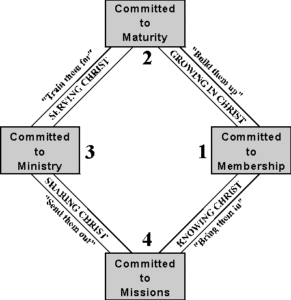 The purpose driven church provides a method of organising and running a local church. It defines five purposes which are intended to work together, synergistically to facilitate church growth and evangelism.
The purpose driven church provides a method of organising and running a local church. It defines five purposes which are intended to work together, synergistically to facilitate church growth and evangelism.
- Link: Amazon
- Length: 400 pages
- Difficulty: Easy
- Topic: Church, Evangelism, Ministry
- Audience: Mainstream Christians
- Published: 1995
The author of the book is Rick Warren. Warren has written a few influential books under the banner of ‘Purpose Driven’: Purpose Driven Life, Purpose Driven Youth Ministry and this one, Purpose Driven Church. All three have been around for awhile, though it appears he’s come out with later editions.
What kind of book is this? At times I distinguish theology into two different categories of my own making. Hard theology and soft theology. Hard theology is concerned with exegesis, biblical and systematic theology. This is generally where I spend most of my time. Soft theology is a bit more fuzzy and touchy feely. Church growth, self help manuals, broadly speaking – practical application of biblical themes and concepts. This book in my opinion falls into the category of soft theology.
The book has a fair amount of fluff. That is, it is filled with stories and anecdotes used to emphasise and justify his church management system and process. That can be a good thing, for example when the material is dry. However the topic for this book is fairly interesting. I felt the fluff was needed because the real core of this book would actually be quite short. That is, Warren is padding it out. For the most part then I will give an overview of the core of this book which is in part two.
I’ve had some exposure to what I think is a similar-tweaked version of this system in operation. I’ve read this book to get a better understanding of the system and also to communicate it to friends in my church.
This post is one of my book reviews. See these links for other reviews by 9Marks, Pastors.com and Tim Clemens (Australian 5M’s review).
Contents
- Part One – Seeing the Big Picture
- 1. The Saddleback Story
- 2. Myths About Growing Churches
- Part Two – Becoming a Purpose-Driven Church
- 3. What Drives Your Church?
- 4. The Foundation for a Healthy Church
- 5. Defining Your Purposes
- 6. Communicating Your Purposes
- 7. Organizing Around Your Purposes
- 8. Applying Your Purposes
- Part Three • Reaching Out to Your Community
- 9. Who Is Your Target?
- 10. Knowing Whom You Can Best Reach
- 11. Developing Your Strategy
- Part Four – Bringing In a Crowd
- 12. How Jesus Attracted Crowds
- 13. Worship Can Be a Witness
- 14. Designing a Seeker-Sensitive Service
- 15. Selecting Your Music
- 16. Preaching to the Unchurched
- Part Five – Building Up the Church
- 17. Turning Attenders into Members (Congregation)
- 18. Developing Mature Members (Committed)
- 19. Turning Members into Ministers (Core)
- 20. God’s Purpose for Your Church
Five Purposes
Scriptural Warrant
Warren attempts to base his five purposes on what scripture commands Christians to do. This is possibly the place where in order to justify certain practices and theories about church, most good exegetical practices are thrown out the window. Rabbits are pulled out of hats, people vanish and magic happens.
In my opinion churches in New Testament times were quite small, had only the beginnings of hierarchy and structure (and even then they seem varied) and did what they could (sometimes failed) to survive physically, politically and spiritually. Trying to derive what we see of these churches and then apply them to today’s much larger and well organised churches is a bit of wishful thinking I believe.
However given that, I think if one looks at many churches today, their makeup and structure will share common features regarding how Christians meet together, communicate with and worship God. In my opinion, these common features are: the worship service (scripture exposition, prayer), home groups, pastoral care and evangelism, remembering all these need a base of volunteer workers to keep the ship running.
Warren predicates his five purposes (p102-105) on the two greatest commandments (Mt 22.36-40) and the great commission (Mt 28.36-40). And from these he gets, worship (Magnification), ministry (Ministry), evangelism (Mission), fellowship (Membership) and discipleship (Maturity). I felt his applications from these passages a bit forced. For example, how he got pastoral care/fellowship out of the command to baptise seems to me to be a bit far fetched. However, he had to write something in order to justify his five purposes biblically.
Diagrams
Warren himself uses two diagrams to explain various concepts. A set of concentric circles describing target audiences (or people groups) and a baseball diagram showing the relationship of the five purposes. I felt the set of concentric circles was helpful in displaying interrelated levels of commitment and target audiences. The baseball diagram is obviously Americanised (in reviews of this book it occasionally draws flak), but like most diagrams it is replaceable. Read a few of these soft theology books and one realises the diagrams can be swapped out with others to emphasise or de-emphasise aspects of the system.
Structure
Each target audience (people group or circle of commitment) corresponds to a purpose of the church.
Program around your purposes. You need to choose or design a program to fulfill each of your purposes. Remember, each Circle of Commitment also corresponds to a purpose of the church. If you use the five circles as a strategy for programming, you’ll identify both your targets (community, crowd, congregation, committed, and core) and your objective with each target (evangelism, worship, fellowship, discipleship, and ministry). (141)
Rather than organizing by traditional departments, organize around purpose-based teams. At Saddleback every lay ministry and every staff member is assigned to one of our five purpose-based teams. In turn, each team is led by a team pastor, assisted by a team coordinator, and composed of a combination of paid staff ministers and volunteer lay ministers. Together they lead the programs, ministries, and events that fulfill the particular purpose assigned to that team. (147)
This is an overview of the core concepts of his system drawn together, the target audiences, the purposes and the teams driving those purposes. The diagram below is mine. It visualises how I understand Warrens system and shows the process and hierarchy running the church.
(Note: Warren makes a distinction between his ‘purpose based teams’ and ‘traditional departments’ without defining what he means by ‘traditional departments’. I wonder had he done so he would have highlighted a fair amount of commonality. If so, he’s just repackaging what is already used by many churches with a few tweaks. There are a few elements I think unique to his system that I will further highlight as I go along.)
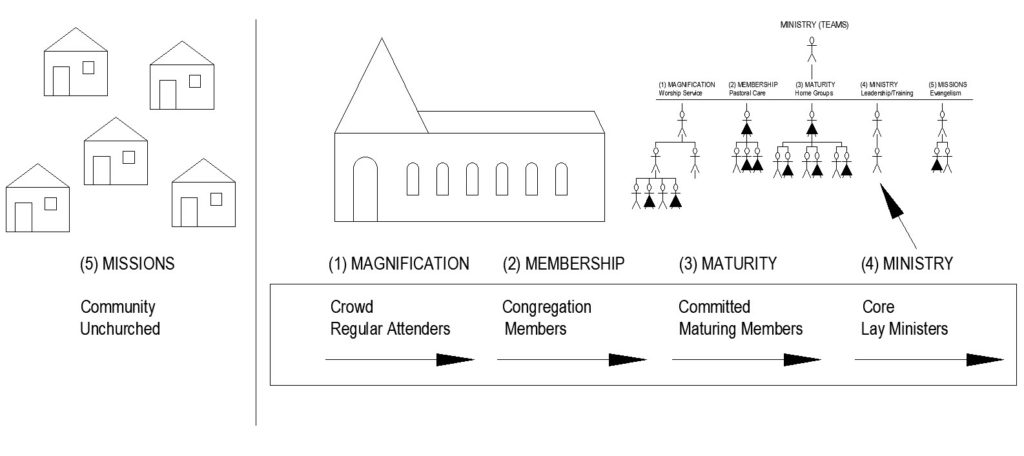
The diagram above will hopefully be clear. The hierarchy on the top right represents the five purpose oriented teams, each with a team leader, all sitting under the minister (grand poobah) in charge.
Now I will walk us through the five purposes (5M’s) with quotes describing their associated target audience and the team driving this purpose.
Where to start?
Chicken or the egg? Mission Team (Start from scratch and evangelise) or Core Ministry Teams (Start from existing church and reorganise or Church plant)? Warren seems to have written on the assumption that his readers are in the position of setting up five teams from existing members of their churches. Yet as he will say below, community and therefore mission (evangelism) is the starting point.
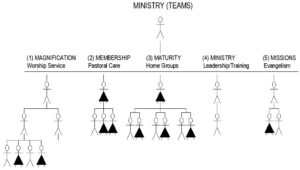
Given standard churches need a worship service, home groups, pastoral care, evangelism and a volunteer base of workers I would expect church ministers would have a good idea of the roles and number of people needed to get a ‘skeleton crew’ church up and running.
So here are the five purposes, their target audience, the team and their purpose.
Community (Evangelistic Events)
People Group: The Community. The community is your starting point. It is the pool of lost people that live within driving distance of your church that have made no commitment at all to either Jesus Christ or your church. They are the unchurched that you want to reach. Your community is where the purpose of evangelism takes place. (130)
The Team and Purpose: Missions. The missions team is assigned the purpose of evangelism. Their target is the community.
Their job is to plan, promote, and oversee all of the church’s bridge events, seeker groups, evangelism training (including Class 401), evangelistic activities and programs, and mission projects. They are to organize whatever it takes to reach our community and our world for Christ. (147)
Mission is the ‘M’ word representing by and large evangelism. Warrens system starts with the community and therefore evangelism. His book tells the story of how he started Saddleback church. He started it from scratch. By way of comparison, I assume many churches today start from church plants. They start with a committed teams of people, only afterwards does the community come. In Warrens case, he canvassed his local community and started a small home group. It just grew and grew. Warrens story is a testament to his drive, vision and hard work.
Crowd (Worship Service)

People Group: The Crowd. The next circle inward represents the group of people we call the “Crowd.” The crowd includes everyone who shows up on Sundays for services. They are your regular attenders. The crowd is made up of both believers and nonbelievers—all they may have in common is that they are committed to attending a worship service every week. (131)
The Team and Purpose: Magnification/Music. This team is assigned the purpose of worship. Their target is the crowd.
Their job is to plan and oversee our weekend seeker services, special worship emphases and events, and to provide music and worship resources to the rest of the church. (148)
A few notes: The first role ‘weekend seeker services’ highlights their role also overlaps with the missions team. This might be helpful to keep in mind when categorising different roles in the church.
Another thing to note is the differentiation he makes between ‘seeker’ services for unbelievers and normal services for believers. I know my own denomination will argue the differentiation is unwarranted. The one service and sermon ought to cater to both believers and non-believers, which in itself is implied from 1 Cor 14.23. Paul here I think also implies everyday services not to overuse Churchianity jargon which non-believers will not understand.
Many of these jobs are event driven, however the last (‘provide music and worship resources’) seems part of the bread and butter weekly worship services to me. Which obviously is a lot of ongoing work. I know my church leaders like to provide direction in the selection of songs in church to compliment their sermon purpose. So I would assume the church minister would provide a bit of direction here.
Congregation (Pastoral Care)

People Group: The Congregation. The congregation is the group of official members of your church. They have been baptized and have made a commitment to be a part of your church family. They are now more than attenders, they are committed to the purpose of fellowship. (132)
The Team and Purpose: Membership. This team is assigned the purpose of fellowship. Their target is the congregation.
It is their business to care for the flock. They run our monthly class for prospective members (Class 101). They oversee all support groups, weddings, funerals, pastoral care, hospital visitation, and benevolence within the congregation, and they operate the counseling center. (148)
Obviously pastoral care is a big aspect of the membership purpose. Many of the roles here are very people based. It’s not unusual for a church to have a pastoral care team. Those who care for and pray for people going through tough times and those in need.
One would normally think of a paid minister doing many of these services. E.g. weddings, funerals (both of which can have preaching) and hospital visitation. Though perhaps the rationale is to free up the minister to do what he wants.
It’s ironic, that while the command to baptise is the impetus for this purpose, the team which drives this purpose is not described as the ones who baptise. Why? Some jobs in church are specifically reserved for ordained ministers, not laity.
Committed (Home Groups)

People Group: The Committed. Do you have people in your church who are godly and growing—people who are serious about their faith—who for one reason or another are not actively serving in a ministry of your church? We call these people the “Committed.” They pray, give, and are dedicated to growing in discipleship. They are good people, but they have not yet gotten involved in ministry. … A commitment to three spiritual habits: (1) having a daily quiet time, (2) tithing ten percent of their income, and (3) being active in a small group. (133)
The Team and Purpose: Maturity. The maturity team is assigned the purpose of discipleship. Their target is the committed.
Their goal is to lead our members to deeper spiritual commitment and help them develop to spiritual maturity. This team operates the monthly Class 201 and is responsible for the Life Development Institute, the midweek worship service, all Bible studies, growth groups in homes, and special church-wide spiritual growth campaigns. They also produce family devotional guides, Bible study curriculums, and other resources to help believers grow. (148)
They may well go by other names, depending on what the minister wants to reinforce. I call them home groups. These are small groups of people that meet in peoples homes, a bit like micro churches. They meet to read the bible, pray, offer pastoral care and encourage one another in the Christian life. IMO home groups do most of the heavy lifting for church fellowship and discipleship. They can also be the primary mechanism for getting jobs done (e.g. welcoming, supper, collection) in the church.
A big emphasis in what Warren seems to be showing above is growth through bible study. This team to his mind is responsible for writing many of the bible studies used in church.
Core (Team Leadership)
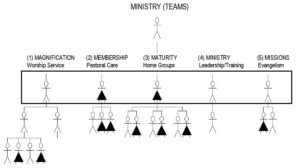
People Group: The Core. The “Core” is the smallest group, because it represents the deepest level of commitment. They are the dedicated minority of workers and leaders, those who are committed to ministering to others. They are people that lead and serve in the various ministries of your church as Sunday school teachers, deacons, musicians, youth sponsors, and so forth. (134)
The Team and Purpose: Ministry. This team is assigned the purpose of ministry. Their target is the core.
Their job is to turn members into ministers by helping members discover their SHAPE for ministry and guiding them to find either an existing place for ministry or a new ministry. This team operates the Ministry Development Center, and is responsible for all service groups as well as for the monthly Class 301 and SALT meetings. They also assist, train, and supervise the lay ministers of the church. (149)
The core represents those involved in ministry in the church. Then we have leadership of the core. In the diagram above, I’ve put a box around the ministry team leading the core. It could very well include another level down or more than one person in leadership for each team. But this will give you the idea this team is the leadership of the core, not the whole core. In turn this core I would assume is lead by the minister in charge.
I generated this table of requirements;
| Community | Crowd | Congregation | Committed | Core | |
| Church Attendance | – | Yes | Yes | Yes | Yes |
| Baptised | – | – | Yes | Yes | Yes |
| Quiet Times, Giving, Small Group | – | – | – | Yes | Yes |
| Ministry Involvement | – | – | – | – | Yes |
If you get to the core, you can be confident you’re going to heaven. On top of this are the various courses people attend from time to time, regular meetings and covenants which need to be signed off. If I added these courses, meetings and covenants to the table, it all looks fairly tiring for the members. But at least the paid staff will have lots of work to do. In practice one could pile a lot of work on members, remembering to make sure the sermons keep telling them how sinful they are and that their ‘good’ works are just filthy rags.
Part of Warrens description of their job is to ‘turn members into ministers’ and ‘guide’ them to find some sort of ministry. This leads us into the next point. How the five purpose driven teams not only provide a means of organising people into groups, but drive their movement from one group to another.
Applying Your Purposes
This is how Warren sees the purpose driven teams working together to form an overriding process for the church.

Assimilate new members on purpose. Use the Circles of Commitment as your strategy for assimilating people into the life of your church.
Begin by moving the unchurched from the community to your crowd (for worship).
Then move them from the crowd into the congregation (for fellowship).
Next, move them from your congregation into the committed (for discipleship), and
from the committed into the core (for ministry).
Finally, move the core back out into the community (for evangelism).
This process fulfills all five purposes of the church. (137, bold mine)
My wife and I experienced the assimilation process when we first moved into our current church which incorporates the similar 5M system.
Assimilation is the task of moving people from an awareness of your church to attendance at your church to active membership in your church. (308)
I had no problem. I feel part of being in a church requires reciprocating what we receive by getting involved in some sort of ministry. My primary service to God however is this blog. My busy wife (of two young children) however felt pressured. She was repeatedly encouraged through various means to get involved. The pressuring I perceived to be intentional and part of a wider church process.
Now the quote above highlights not only assimilation – sorting newcomers into a group, but a movement (or desired progress) from one group to another. Warren says, the process of moving people from one group to another, is what fulfills the five purposes. I think completes is a better word.
So in other words, each team hasn’t completed their job with a given individual or group of people until they have moved them on to the next group.
And the church as a whole has not completed its purpose / job if every one of its teams isn’t working as well.
This process can be measured.
Key Performance Indicators

Evaluate on purpose. To remain effective as a church in an ever-changing world you need to continually evaluate what you do. Build review and revision into your process. Evaluate for excellence. In a purpose-driven church, your purposes are the standard by which you evaluate effectiveness. …
At Saddleback we’ve developed a tracking tool we call the “Saddleback Snapshot.” Our pastoral staff reviews it each month. The Snapshot is a six-page overview of our disciple-development process. It identifies who is at each base of our Life Development Process (baseball diamond). Like the old Abbott and Costello routine, we want to know “Who’s on first?”
The Snapshot also shows how many people are currently in each Circle of Commitment, and measures a number of other key indicators of church health.
The Snapshot forces us to take an honest look each month at how well our church is fulfilling its purposes. Bottlenecks in the system become easy to spot. For instance, if worship attendance increases 35 percent in a year but membership and small group attendance only increases 20 percent, we know we’ve got to rectify some gap in the process.
Statistics like this help us evaluate our assimilation process and determine where emphasis is needed. As I mentioned in an earlier chapter, we must be constantly asking, “What is our business?” and “How’s business?” (151-2)
Purpose Driven churches are always counting their members. Maybe a course on basic mathematical statistics ought to be included in Theology degrees? I know these skills are often part of a ministers admin work. Are these skills part of the New Testament qualifications for a leader in the church? I don’t really see much evidence for that. We ought to remember faithfulness is the measure of success, not numerical growth. However it’s fair enough to be able to have some objective standard by which one can measure the health of a church. If you can think of another, please feel free to comment.
In the back of my mind, I’m also thinking that getting an understanding of a church’s health involves actually getting to know the person or group rather than counting bums on seats. Paul shared his very own self with those he was ministering to (1 Thes 2.8). Relational over statistical.
If one is specifically looking for a group of behaviours to grade one group from another. Is this judgement approaching what Paul was opposing when he talked about justification by faith apart from works of law. In the NT, Paul’s Judaising opponents identified who the righteous were by a set of observable works, is this the same only with a different set of works? Are the ‘mature’ a subset of Christians (1 Cor 2.6)? Is there Jew and Greek, slave and free, male and female (Gal 3.28)? Will we show partiality to some and not others (Jas 2.1-4)?
Church Planting?
It seems to me this purpose driven church / 5M process could easily be tweaked to facilitate church planting. At the end of Warrens process. The core are sent out into the community. Thus the purpose driven church appears to me to be a circular system.
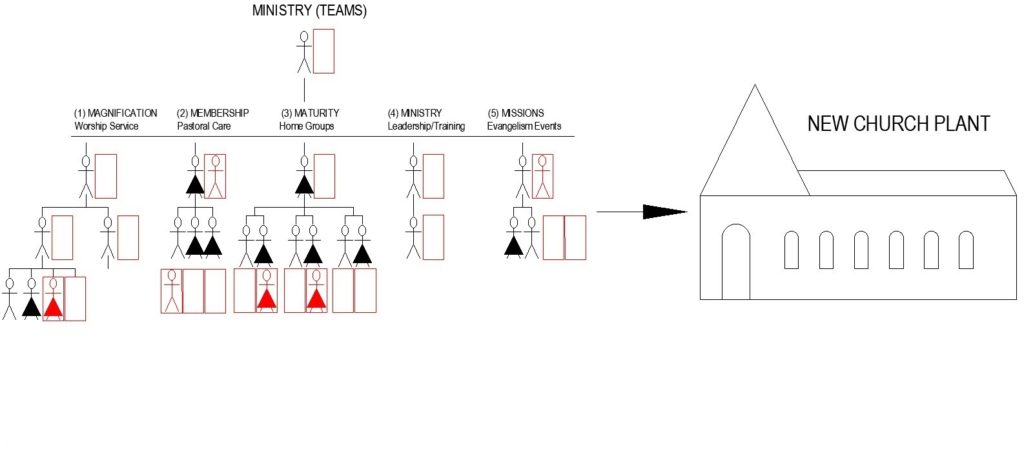
However, instead of sending them out into the community to evangelise, they could be part of the original core planting a new church. Thus assimilating people into a ministry in my mind may be part of an intentional process to generate enough people in ministry to start a new church. All that is required here is to quantify the roles needed for a given church to operate, fill these positions beyond what is needed (also – on the job training), then when sufficient numbers covering necessary roles are covered the church is primed to church plant. Ding! Were ready, lets go.
But is this may short circuit Warrens intention to disciple members. Perhaps it is his understanding that actually participating in evangelism – sharing the gospel with the community – is an important part of the spiritual growth of a person.
Reflections and Reservations
Who is your daddy?
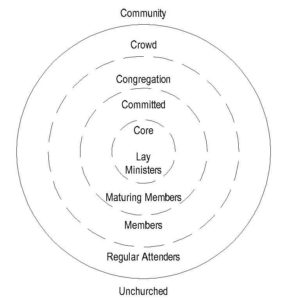
Paul’s criteria for leadership of churches is well known (1 Tim 3.1-13; Tit 1.5-9). For me, Paul equates church with family and the family is headed by the father (1 Cor 4.15).
According to Eph 4.11, I’m comfortable calling church leaders ‘shepherding teachers’ and to affirm their role is in building up the church. But I’m reluctant to think Paul’s mention of apostles, evangelists and prophets in this list suggests leadership in the church is meant to be four fold. Some of these roles are clearly meant to function outside the church.
It’s not an explicit point in the book, but it is implied throughout. The book itself has an implied audience and assumes they are in charge of a single congregation. The congregations leader(s). It’s written with the assumption: One leader, one congregation and the five teams are bound to that one congregation.
But what about the case where a single church building houses several congregations?
I’ve been witnessing a similar implementation of this system which has four congregations in the one building. A traditional / aged congregation, a typical family style congregation, an adult congregation (generally older singles) and a uni student congregation. In each case the implementation of this system has left them without a leader on top of each congregation.
In my opinion this is an incorrect implementation of Warrens system. In this case, it’s one minister in charge and giving oversight over four distinct congregations. With approaching one thousand in attendance every given week, I can’t imagine one minister can keep tabs on this many congregations.
If there isn’t a person in charge of each congregation then it raises a few questions: Who does the year calendar programming for each congregation? Who is the goto person when new people have a question? Who is motivating and encouraging each of the teams? Keeping them on track? Setting their goals? What about activities which involve multiple purposes at the same time? Who ultimately has authority in the congregation? Moses had to make certain judgments when his judges could not (Ex 18.13-27). Who is the Moses equivalent here?
Silo Mentality?
Having multiple teams without a single leader keeping tabs on them may create problems in itself.
The word silo originally referred to storage containers for grain or missiles, but it is now used as a metaphor for separate entities that stockpile information and effectively seal it in. In business, it refers to an organization that is made up of divisions that operate independently and avoid sharing information. (https://www.investopedia.com/terms/s/silo-mentality.asp)
According to Clemens review above this is a commonly cited problem with the 5M’s system. Communication across five purpose driven teams may be a problem. What if there is a pastoral care issue, how will people talk? What about sensitive issues that may come up. How would a purpose driven / 5M church manage church discipline?
Often in church there is significant overlap in these purposes. Which team drives a shared event? Can home groups run their own evangelism project? Clearly Warren envisages seeker services require the mission team to direct the magnification team. Some might want to do the task because its ‘their job’. Others might be of the opposite mindset, ‘it’s not my job’.
I’m not saying a purpose driven church cannot deal with these, but they may well require good communication mechanisms, which of course means more work. More work than would otherwise be done in a standard congregational system. Otherwise I fear the quality and efficiency of these purposes will suffer.
Greater Demand on Volunteers
This could be good or bad. The leader is definitely pushing work down on others, reserving more time for what he or she wants to do.
This could be good, because being involved in ministry is a great place to be to promote God’s kingdom, grow spiritually and in skills and experience. I certainly have grown a lot by a couple of decades leading youth and children’s ministries.
But a possible downside is ministry overload, burnout and inexperience prone mistakes. Well intentioned people can be taken advantage of to do more than they ought. Sometimes the job takes more importance than the care of the person doing it.
Another less obvious downside is that if one fills up members time working in the church, they don’t have as much time and energy to evangelise outside the church. This is especially true I think with the church planting variant. People aren’t being sent out. Given the decline in church membership in the West, I think churches today need to spend more time doing ministry outside the church rather than in. This can mean being intentional in making relationships and developing our ability to share the gospel with not yet Christians. (Note: Which is why I’ve reviewed several Gospel Sharing books on this blog).
Where does God fit in?

Is this a church system made into a franchise? E.g. The church equivalent of McDonalds. A franchise is a type of license that a party (franchisee) acquires to allow them to have access to a business’s (franchisor) proprietary knowledge, processes, and trademarks in order to allow the party to sell a product or provide a service under the business’s name (https://www.investopedia.com/terms/f/franchise.asp). A common critique of some churches today is that they are seeking to be more like the secular businesses around them.
How does God and grace fit in? Remember my wife’s experience with being assimilated into church ministry. It wasn’t left to my wife to join of her own volition. She was actively encouraged through repeated requests. Is the Gospel driving this practice? Or does it rely on the team leadership pressuring people to move into the next group that facilitates the growth? If my wife put her foot down and said, ‘Not yet’, how would she have been made to feel? It’s one thing to say the gospel is transforming people and facilitating church growth, but it’s another if movement from group to group is promoted by badgering.
Along similar lines, how can one tell the difference between God’s work and grace and our work and effort. Paul says God is the one who makes a church grow (1 Cor 3.6-7). Acknowledging that, I think Christians can do a lot of work in their own strength and then pawn it off as God’s work to downplay their ingenuity and work. How can we tell the difference between the fruits of this system and that of any other corporate system transferring people from one group to the next and sending them out? E.g. a school.
I guess my overriding question here is, ‘Does it leave room for God’? Because I think this kind of system can be applied quite easily in man’s strength and not leave room for God.
Recommendation
This book provides a well worked system for facilitating church growth and evangelism. It is easy to read and engaging. Warrens passion for church is notable. I found the book had a bit of fluff with stories and anecdotes to cover for the brevity of the content. For the most part this contributed positively to the reading.
I found the content of the book clear and understandable. The purpose driven church gives a working system for managing churches and organising people.
This of course assumes the one leader, one congregation, five teams structure is maintained as I believe Warren has directed. If this is not implemented the system will manifest problems in my opinion.
Given I’m no church growth / management expert – In my opinion it’s better to have a clear understanding and process of how one wants to run their church, so overall I would recommend the implementation of this system.
Copyright © Joshua Washington and thescripturesays, 2020. All Rights Reserved.

